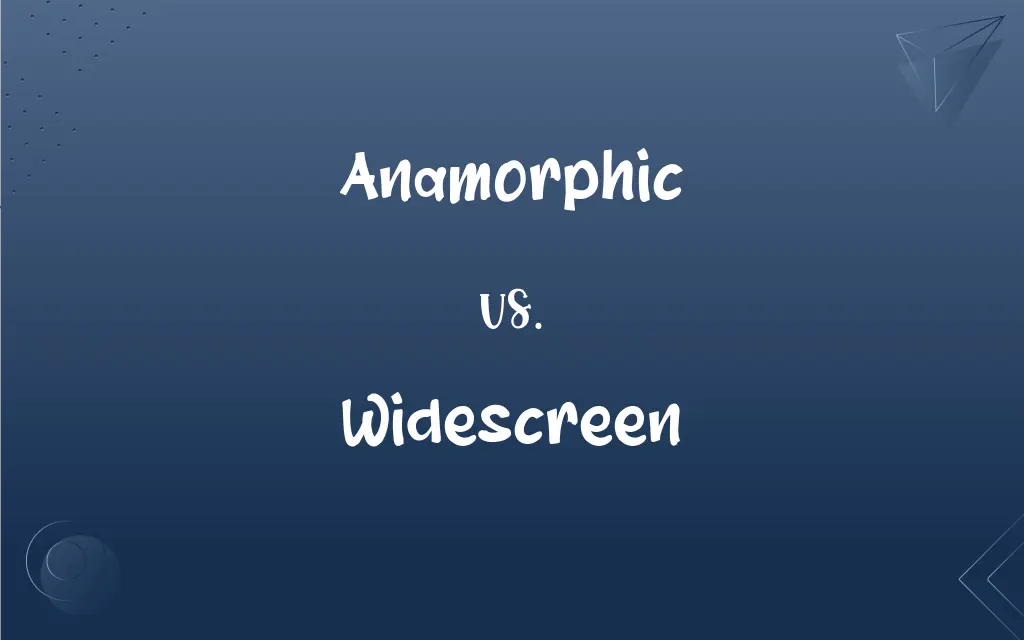Anamorphic vs. Widescreen: What's the Difference?
By Aimie Carlson || Updated on May 22, 2024
Anamorphic enhances image quality by horizontally compressing it for recording and then expanding it for viewing, while widescreen refers to a broader aspect ratio that provides a wider field of view.

Key Differences
Anamorphic refers to a technique used in film and photography where the image is horizontally compressed during recording and expanded during playback. This process allows for a higher resolution and quality by utilizing more of the film's area. Widescreen, on the other hand, describes an aspect ratio wider than the traditional 4:3, commonly 16:9 or 21:9, providing a broader field of view and a more immersive experience.
Anamorphic lenses create distinctive visual effects, such as lens flares and oval bokeh, which are often sought after for their aesthetic appeal. Widescreen formats achieve a wide viewing experience without these optical effects, focusing on the broader scene rather than specific visual traits.
Anamorphic techniques are used to maximize the resolution and image quality on physical film, making it essential in professional filmmaking. Widescreen formats are prevalent in modern digital media, including televisions and computer monitors, to enhance the viewing experience.
Anamorphic images require specific lenses and projection systems to correct the compressed image, whereas widescreen formats are inherently displayed correctly on compatible screens without needing special equipment.
Anamorphic is often chosen for its unique visual style and quality benefits in cinematic productions. In contrast, widescreen is standard across many media platforms for its ability to present content in a more expansive format.
ADVERTISEMENT
Comparison Chart
Image Compression
Horizontally compressed
No compression
Aspect Ratio
Variable, often 2.39:1
Typically 16:9 or 21:9
Visual Effects
Distinctive lens flares, oval bokeh
Standard visual characteristics
Equipment Required
Special lenses and projectors
Standard displays
Usage
Professional filmmaking
TV, monitors, digital media
ADVERTISEMENT
Anamorphic and Widescreen Definitions
Anamorphic
Enhances image resolution by using more of the film's area.
Anamorphic filming was essential to capture the epic landscape scenes.
Widescreen
An aspect ratio wider than the traditional 4:3 format.
The widescreen format of the TV made the movie more immersive.
Anamorphic
A technique for recording images with a horizontally squeezed aspect ratio.
The director opted for anamorphic lenses to achieve a unique cinematic look.
Widescreen
Standard for modern digital media and devices.
Most new televisions come with a widescreen format by default.
Anamorphic
Involves specific lenses to compress and decompress the image.
The anamorphic lens added a striking depth to the film's visuals.
Widescreen
Enhances viewing by fitting more of the scene into the frame.
The widescreen display allowed the entire game field to be visible.
Anamorphic
Requires specific projection methods to display correctly.
The theater had to use anamorphic projectors for the premiere.
Widescreen
Provides a more immersive and expansive visual experience.
The widescreen monitor was perfect for multitasking and watching videos.
Anamorphic
Relating to, having, or producing different optical imaging effects along mutually perpendicular radii
An anamorphic lens.
Widescreen
Commonly 16:9 or 21:9, offering a broader field of view.
She preferred watching films in widescreen for a cinematic experience.
Anamorphic
Of or relating to a widescreen film or video that has been converted to a storage format with a lower aspect ratio by shrinking the image only along the horizontal axis in order to minimize loss of resolution
An anamorphic DVD for widescreen televisions.
Widescreen
Of or relating to a display screen or an image with a width-to-height ratio greater than 4:3 and a typical ratio of 16:9.
Anamorphic
Producing various optically distorted images.
An anamorphic lens
Widescreen
A screen with a wider aspect ratio than the ordinary 35-millimeter frame, making more effective use of the human field of view and producing a more immersive view experience.
Anamorphic
(mycology) Of or relating to the anamorph, an asexual stage in the development of certain fungi.
Widescreen
(film) Filmed in a greater aspect ratio than the 1.33:1 or 1.37:1 aspect ratio.
Anamorphic
Pertaining to gradual evolution from one type of organism to another
Widescreen
(of a motion picture) Presented in the original aspect ratio; presented in letterbox orientation.
Anamorphic
Pertaining to a kind of distorting optical system;
An anamorphic lense
Anamorphic
Produces characteristic lens flares and oval bokeh effects.
The anamorphic lens created beautiful lens flares in the sunset shots.
FAQs
Do anamorphic images need special equipment?
Yes, anamorphic images require specific lenses for recording and special projectors for proper playback.
What is anamorphic in filmmaking?
Anamorphic is a technique that compresses the image horizontally during recording and expands it during playback to enhance resolution and quality.
What is a widescreen format?
Widescreen refers to a broader aspect ratio, typically 16:9 or 21:9, that offers a wider field of view compared to traditional formats.
Are widescreen formats standard for all media?
Yes, widescreen formats are standard for most modern digital media, including TVs and computer monitors.
What aspect ratios are considered widescreen?
Common widescreen aspect ratios are 16:9 and 21:9.
Can anamorphic be used in digital media?
While traditionally used in film, anamorphic techniques can also be applied to digital media for stylistic effects.
How does widescreen enhance viewing experience?
Widescreen formats provide a broader view, making the content more immersive and suitable for modern screens.
Why use anamorphic lenses?
Anamorphic lenses are used to achieve higher image resolution and unique visual effects like lens flares and oval bokeh.
Are there any disadvantages to using anamorphic lenses?
Anamorphic lenses can be expensive and require specific projection methods, which might not be suitable for all types of production.
Does anamorphic affect the image's aspect ratio?
Yes, anamorphic affects the aspect ratio by compressing it during recording and expanding it during playback.
What are the visual characteristics of anamorphic filming?
Anamorphic filming is known for its distinctive lens flares, oval bokeh, and high-resolution imagery.
Can anamorphic lenses be used with digital cameras?
Yes, anamorphic lenses can be used with digital cameras for capturing high-quality, cinematic footage.
How does anamorphic compression work?
Anamorphic compression works by squeezing the horizontal aspect of the image during recording and then expanding it during playback.
Why did widescreen become standard?
Widescreen became standard because it enhances the viewing experience by providing a broader and more immersive field of view.
What equipment is essential for widescreen viewing?
Modern widescreen TVs, monitors, and projectors are essential for widescreen viewing.
What are the benefits of widescreen monitors?
Widescreen monitors offer more screen space for multitasking and a better viewing experience for videos and games.
Is special software needed to edit anamorphic footage?
Yes, editing anamorphic footage typically requires software that can handle the compression and decompression processes.
Is widescreen more suitable for gaming?
Yes, widescreen is often more suitable for gaming as it provides a broader field of view.
What content is best viewed in widescreen?
Movies, TV shows, and video games are best viewed in widescreen for an immersive experience.
Why is widescreen preferred for movies and TV shows?
Widescreen is preferred because it offers a more cinematic and immersive viewing experience.
About Author
Written by
Aimie CarlsonAimie Carlson, holding a master's degree in English literature, is a fervent English language enthusiast. She lends her writing talents to Difference Wiki, a prominent website that specializes in comparisons, offering readers insightful analyses that both captivate and inform.































































